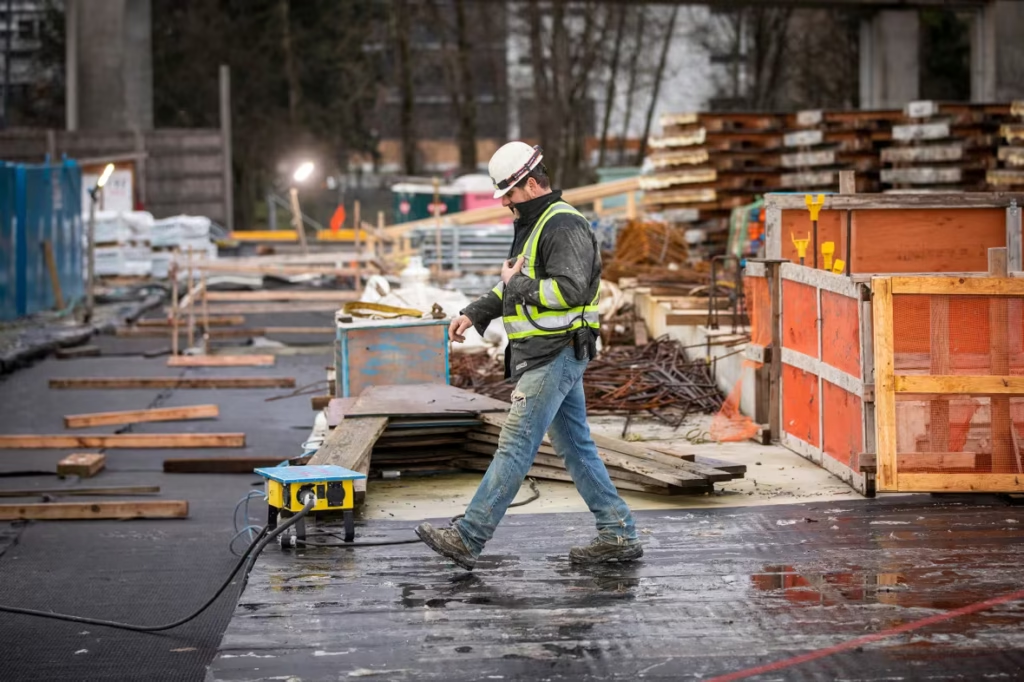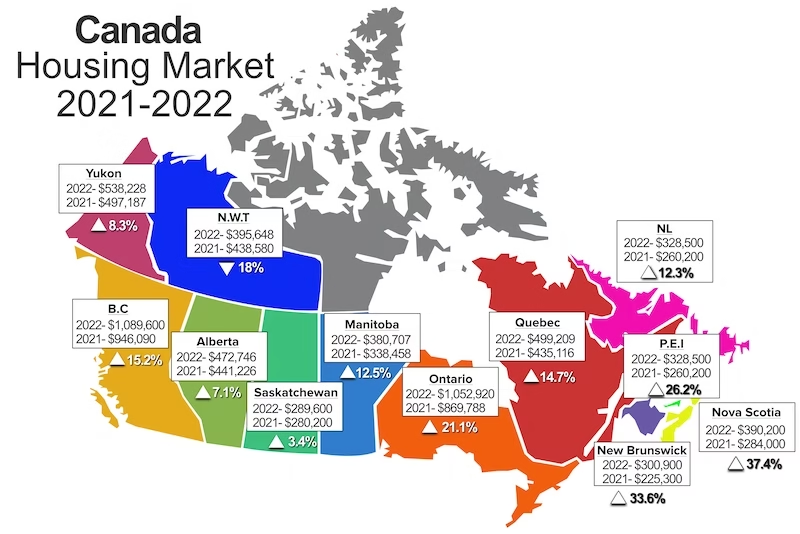The Canadian real estate market faces a turning point as election promises alter the investment map. The market shows average home prices of $678,000, dropping 3% from last year, while sales have fallen by almost 8%. The silver lining comes from an 18% rise in available homes, which creates fresh opportunities in these changing times.
Major parties have shown their bold housing plans that will affect market patterns by a lot. The Liberal Party wants to build twice as many homes, reaching 500,000 annually by 2030. They've introduced Build Canada Homes with $25 billion in debt financing. Their Housing Accelerator Fund puts $4 billion toward urban housing until 2026-27. The Conservative Party takes a different approach. They want builders to increase home construction by 15% each year and remove GST on homes under $1.3 million. The Bank of Canada's key interest rate sits at 2.75%, down from over 4%. Major cities struggle with rental vacancies below 2%. These conditions mean investors need to pay close attention to the Canadian real estate market right now.
Parties unveil housing plans that reshape investor expectations
Canadian real estate market is about to change as major parties show their ambitious housing strategies during federal election campaigns.
Liberals propose Build Canada Homes to double housing supply
The Liberal Party plans to create Build Canada Homes (BCH), a federal agency that will focus on large-scale affordable housing development. BCH would get over CAD 34.83 billion in financing to support advanced prefabricated home builders. The agency would also receive CAD 13.93 billion in low-cost financing for affordable housing builders. The government wants to double Canada's housing construction to nearly 500,000 homes each year over the next decade. This represents a big change in federal housing policy.
The Liberals want to cut municipal development charges by half for multi-unit residential housing. This could save around CAD 55,734 on a two-bedroom apartment in Toronto. Their plan brings back the Multiple Unit Rental Building (MURB) cost allowance - a tax incentive that helped create nearly 200,000 rental units between 1974-1981.
Conservatives push for faster approvals and land sales
The Conservative Party takes a different approach by focusing on city-based targets. Their plan requires cities to build 15% more homes each year. Federal funding would depend on meeting these targets. Cities that exceed targets would get bonus funding, while those falling short would see reduced funding.
The Conservatives promise to turn 15% of federal buildings and lands into housing in their first 100 days in office. This could create 288,000 new homes based on their estimates. They want to deliver 2.3 million new homes over five years by making approvals faster and removing regulatory barriers.
Both parties promise GST relief on new homes
The two major parties agree on removing the Goods and Services Tax (GST) on new homes, but their approaches differ. The Liberals would remove GST for first-time homebuyers on homes up to CAD 1.39 million. This could save buyers up to CAD 69,668.
The Conservatives would extend GST relief to all homebuyers for homes under CAD 1.81 million. This offers savings up to CAD 90,568. The Conservatives believe this tax cut would lead to 36,000 more homes being built each year.
These different approaches will shape the Canadian real estate market and affect investment strategies in coming years.
Execution challenges raise doubts about the promised housing supply

Political promises about housing in Canada face tough challenges when it comes to actual delivery. Industry experts warn about basic obstacles that could prevent the Canadian real estate market from reaching its construction goals, despite optimistic political rhetoric.
Labor shortages and factory capacity limit scalability
Canada's construction industry faces a workforce crisis. The country needs more than 500,000 additional construction workers to build enough homes by 2030. Right now, 93,000 construction jobs remain empty across the country. The situation looks even more challenging as 22% of residential construction workers will retire in the next decade. This shortage hits skilled trades and general laborers the hardest.
Recent employment figures paint a clear picture:
- National unemployment sits at 6.5% as of September 2024
- Worker retirements exceed new hires by about 31,000
- 86% of real estate and construction leaders can't find skilled talent, even with increased immigration
The manufacturing capacity for prefab housing components can't keep up with demand. Companies report they're running into material shortages and production bottlenecks frequently.
Rezoning delays and municipal bottlenecks persist
Municipal approvals in Canada move at a snail's pace. The country ranks 37th out of 38 OECD countries, with processes taking three times longer than in the United States. Strict zoning rules and too many regulations cause these delays.
These holdups cost developers between CAD 3,723 and CAD 7,769 monthly, depending on location. This can drive up unit costs by CAD 125,402. Government agencies spend two to three years looking at data before they launch housing programs. This creates a big gap between planning and getting things done.
Historical data shows past targets were missed
Past results don't inspire confidence in current promises. The MURB program from 1974-1981 built 170,000 units, falling short of its 200,000-unit goal. A CMHC report shows it didn't boost rental construction as planned.
Ontario's Ford government just lowered its 2024 housing starts forecast from 87,900 to 81,300. This falls well below the 125,000 target. To hit the government's goal of 1.5 million homes by 2031, Ontario would need 39,900 new units every quarter. That's 74% more than current numbers and 5,500 above the highest quarterly record of 34,400 from 1973.
These roadblocks suggest the Canadian real estate market will struggle to meet the ambitious supply targets that both parties have made central to their housing affordability plans.
Real estate investors assess risks and opportunities post-election
Election policies are prompting real estate investors throughout Canada to recalculate their returns and rethink investment strategies. The market shows tight rental supplies and changing tax policies.
How tax incentives could affect rental yields
GST exemptions on new housing could substantially change investor calculations. Buyers might save up to CAD 55,734 on an average-priced home. The market has already priced in this tax relief instead of adding it separately, which limits direct benefits to investors. Rental property investors must subtract government grants and subsidies from their property's capital cost. This directly changes depreciation claims and long-term returns.
Capital gains partial inclusion remains crucial for investment decisions. The largest seven residential REITs collected CAD 139.34 million in 2022 and distributed it to investors tax-free through partial inclusion of capital gains. These REITs also marked 47% of their distributions (over CAD 282.85 million) as non-taxable income.
Why timing matters for pre-construction investments
Development charges in the Greater Toronto Area jumped about 30% between 2020 and 2022. Some cities now charge more than CAD 139,336 for a typical condo unit. Buyers looking at pre-construction purchases need to account for these rising costs.
Major cities like Toronto and Vancouver maintain rental vacancy rates below 2%. This creates good conditions for landlords even with upcoming supply increases. The government's speed in implementing promised programs will determine investment timing. Past data shows big gaps between program announcements and actual housing delivery.
Impact of policy uncertainty on investor confidence
New data shows worrying trends in investor confidence. Both domestic and foreign investors are pulling out capital at record rates. Foreign investors withdrew a record CAD 12.26 billion from Canadian securities in February. Canadians put a record CAD 33.72 billion into foreign securities. This suggests weakening faith in domestic markets.
Real estate developers and construction companies watch this election closely. Many companies now model different scenarios. They want to find opportunities and tax strategies that will work best when policies change. Investors scrutinize anti-flipping rules, short-term rental restrictions, and ownership limits more carefully. These factors will shape long-term wealth planning strategies without doubt.
Regional markets respond differently to federal housing policies

Canadian housing policies affect regional markets differently. The Canadian real estate market shows varied opportunities and challenges for investors looking for the best returns.
Toronto and Vancouver: High supply, high regulation
Canada's biggest cities face unique challenges despite federal incentives. Toronto and Vancouver saw major drops in housing starts (10-20%). Toronto's numbers fell dramatically with a 65% year-over-year drop in March 2024. Vancouver's growth looks better over time (+97.6% in permits across 12 years). However, builder confidence in British Columbia remains low at 17.2 for single-family sales. Higher regulatory burdens and housing costs that grow faster than incomes cause this pessimism. Vancouver has taken steps by introducing the R1-1 Residential Inclusive zone that allows up to six strata units per standard lot.
Alberta and the Prairies: Investor-friendly conditions
Alberta stands out as the market's bright spot. Calgary and Edmonton saw impressive increases in housing starts (40-70%). Prairie provinces grew by 24% year-over-year. Several factors drive this success. Homeownership costs are about half of Toronto's and Vancouver's. The economy grows 30% faster than other provinces. There are fewer regulatory barriers, too. Alberta has become Canada's fastest-growing province. The average house price (CAD 668,812) sits well below the national average (CAD 989,285). Investors can adjust rental rates based on market conditions since there's no rent control.
Quebec: Balanced growth with moderate policy changes
Quebec shows a middle ground in real estate trends. The market favors stability over dramatic changes. The province expects a small 2% drop in 2024 sales while single-family home prices stay steady. Montreal's activity should level off around 35,000 transactions. Quebec City looks forward to modest price increases (5% for single-family homes, 1% for condominiums). Quebec offers one of Canada's most affordable markets. Young people feel more optimistic here about buying homes - 64% believe it's possible compared to 54% nationally. This balanced approach creates steady investment conditions through moderate policies that support multi-residential development.
2025 Election’s Impact: Key Takeaways for Canadian Real Estate
Looking ahead, Election outcomes will reshape investment strategies
Canada's election will alter the real estate scene. Both major parties have bold housing plans that could transform market dynamics. The Liberals' Build Canada Homes initiative wants to double housing construction, while the Conservatives' focus lies on faster approvals. Each approach tackles Canada's housing challenges differently.
The path forward has big hurdles, whichever party forms the government. Construction worker shortages top 500,000, cities create bottlenecks, and past housing targets fell short - all good reasons to view campaign promises with skepticism. Smart investors who grasp regional market differences will still find opportunities in the Canadian market.
Alberta and the Prairies show promise with stronger economic growth, balanced price-to-income ratios, and fewer regulations. Toronto and Vancouver's markets face supply issues and heavy regulations, yet their long-term growth potential remains strong. Quebec charts a middle course with stable, moderate growth.
The biggest factor to consider is that policy changes need time to show results. Smart positioning before major changes could create real advantages. While questions remain, one thing stands out: investors who get both national policy shifts and local market details will succeed in Canada's changing housing landscape.
FAQs
Q1. How might the Canadian election affect real estate investments? The election could significantly impact real estate investments through proposed housing plans, tax incentives, and regulatory changes. Both major parties have promised to increase housing supply and offer GST relief on new homes, which could reshape market dynamics and investor expectations.
Q2. What are the main challenges in meeting Canada's housing supply targets? Key challenges include severe labor shortages in the construction industry, insufficient factory capacity for prefabricated housing, persistent rezoning delays, and municipal bottlenecks. Historical data also shows that past housing targets have often been missed, raising doubts about the feasibility of current promises.
Q3. How do regional real estate markets in Canada differ in their response to federal housing policies? Regional markets respond differently based on local economic conditions, regulations, and supply-demand dynamics. For instance, Toronto and Vancouver face high regulation and supply constraints, while Alberta and the Prairies offer more investor-friendly conditions with stronger economic growth and fewer regulatory barriers.
Q4. What tax considerations should real estate investors keep in mind? Investors should consider the impact of GST exemptions on new housing, changes in capital gains treatment, and how government grants might affect depreciation claims. It's also important to stay informed about anti-flipping rules, short-term rental regulations, and ownership restrictions that could influence investment strategies.
Q5. Which Canadian regions currently offer the most promising real estate investment opportunities? Based on current trends, Alberta and the Prairie provinces appear to offer compelling investment conditions. These regions boast stronger economic growth, more reasonable price-to-income ratios, and fewer regulatory barriers compared to major urban centers like Toronto and Vancouver. However, investors should always conduct thorough research and consider their individual investment goals before making decisions.
